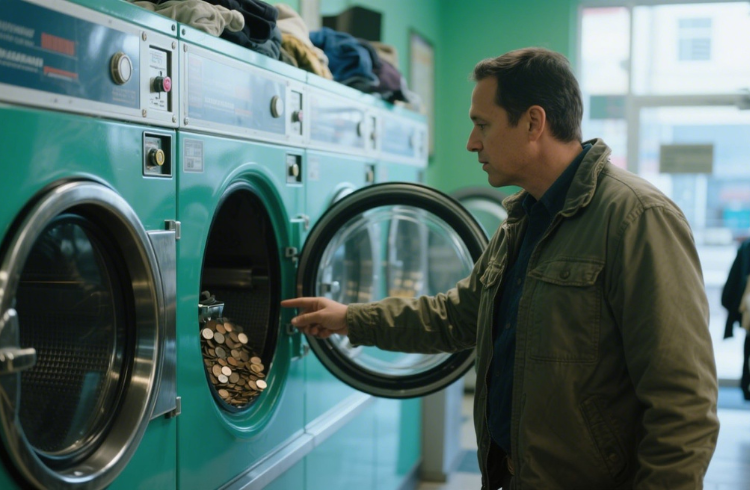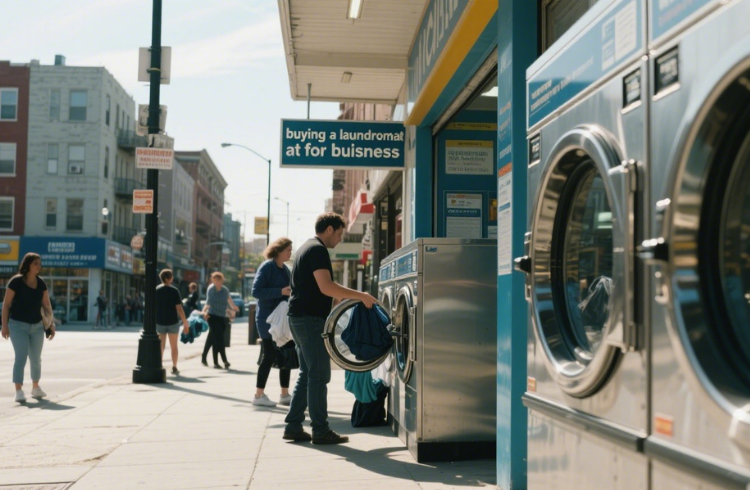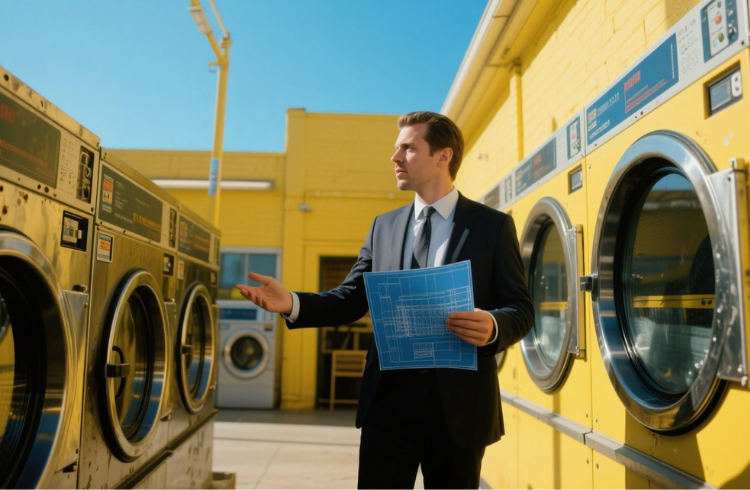Introduction
Investing in a laundromat can be a lucrative venture, especially in urban areas where access to laundry facilities is limited. Buying a laundromat for business offers a unique opportunity to generate steady income while providing a crucial service to the community.
However, entering this market requires careful planning, an understanding of the associated costs, potential revenue streams, and knowledge of challenges that may arise. In this comprehensive guide, we will break down everything you need to know about purchasing a laundromat, from costs and revenues to what pitfalls to avoid.
| Category | Key Points |
| Startup Costs | $100K–$500K for purchase, lease setup, equipment, permits, and legal fees |
| Ongoing Costs | Utilities, repairs, insurance, wages, and marketing |
| Revenue Sources | Self-service, wash-and-fold, delivery, vending, premium add-ons |
| Financing Options | SBA loans, seller financing, bank loans, personal/investor funding |
| Red Flags | Poor financials, short lease, old machines, bad location, low visibility |
| Success Factors | Good location, reliable machines, strong service, community focus, marketing |
| Due Diligence Tips | Review financials, inspect equipment, check lease terms, study local market |
Understanding the Laundromat Business Model
The Appeal of Laundromats
Laundromats are appealing for several reasons:
- Steady Demand: Laundry is a necessity for most households, ensuring a consistent customer base.
- Low Labor Costs: Many laundromats operate with minimal staff, which helps keep operational costs low.
- Flexible Hours: Laundromats can be open 24/7, maximizing revenue potential.
- Potential for Passive Income: Once established, laundromats can provide a relatively hands-off income stream, especially if you automate processes.

Key Considerations Before Buying
Before diving into the purchase, consider the following factors:
- Location: A laundromat in a high-traffic area or near apartment complexes can attract more customers.
- Competition: Analyze the local market to understand the competition and potential demand.
- Current Equipment: Assess the cleanliness and functionality of existing machines and infrastructure.
- Financial Health: Review the current owner’s financial statements to gauge profitability.
Buying a Laundromat for Business
Initial Costs
When considering buying a laundromat, it’s crucial to understand the upfront costs involved. Here’s a breakdown:
1. Purchase Price
The price of a laundromat can vary significantly based on location, size, and existing revenue. On average, expect to pay anywhere from $200,000 to over $1 million.
2. Equipment Costs
If the laundromat needs new equipment, this can add substantially to your initial investment. Commercial washers and dryers can range from $1,000 to $15,000 each. Additional costs for folding tables, carts, and vending machines should also be factored in.
3. Lease or Real Estate Purchase
If you’re leasing the space, consider the lease terms and monthly payments. If you’re purchasing real estate, factor in property taxes, insurance, and maintenance costs.

4. Renovation and Setup Costs
You may need to renovate the space to attract customers. Budget for painting, signage, flooring, and any plumbing or electrical work.
5. Licenses and Permits
Check local regulations for any necessary business licenses and permits. These can cost anywhere from a few hundred to several thousand dollars.
6. Working Capital
It’s essential to have sufficient working capital to cover operational costs for the first few months, including utilities, payroll, and supplies.
Ongoing Costs
After the initial purchase, you’ll encounter ongoing operational costs that you must budget for:
1. Utilities
Laundromats consume significant amounts of water and electricity. Expect monthly utility bills to be substantial, varying based on usage and local rates.
2. Maintenance and Repairs
Regular maintenance is crucial to keep equipment running smoothly. Set aside a budget for routine repairs and unexpected issues.
3. Insurance
Invest in comprehensive insurance that covers liability, property, and equipment damage. Premiums will vary based on location and coverage limits.
4. Staffing Costs
If you plan to hire staff for customer service, maintenance, or cleaning, include salaries and benefits in your budget.
5. Marketing Expenses
To attract and retain customers, invest in marketing efforts, such as local advertising, social media promotions, and loyalty programs.
Revenue Streams: Where Laundromats Make Money
Laundromats earn money primarily through self-service laundry, but many expand their offerings to diversify income. Here are typical revenue streams:
- Self-Service Wash and Dry: This is the core revenue source. Customers pay per load, often through coin, card, or mobile app.
- Wash-and-Fold Services: Some laundromats charge a per-pound rate to wash, dry, and fold clothes for busy customers.
- Pickup and Delivery: An increasingly popular option, especially in urban areas, offering scheduled laundry services for homes and small businesses.
- Vending Machines: Soap, detergent, snacks, and beverages provide passive side income.
- Arcade Games or Wi-Fi: Some owners add extras to increase customer dwell time and satisfaction.
Well-run laundromats can generate monthly gross revenues ranging from $10,000 to $40,000, depending on size, location, and services.

What to Watch Out For
While buying a laundromat can be rewarding, several pitfalls can hinder your success if not carefully managed. One of the most common mistakes is underestimating operational costs—many new owners fail to account for utilities, maintenance, and staffing, which can lead to financial strain.
Regular equipment upkeep is equally vital; neglecting maintenance often results in expensive repairs and unexpected downtime that cut into revenue. Location is another critical factor—a poorly chosen site with low foot traffic or difficult accessibility can limit your customer base significantly.
Additionally, inadequate marketing may prevent your laundromat from gaining visibility in the community, so it’s essential to invest in strategies that attract and retain customers. Excellent customer service is also crucial; friendly, helpful staff can enhance the customer experience and encourage repeat visits.
Financing Your Laundromat Purchase
Securing financing for your laundromat purchase is essential. Here are some options to consider:
1. Traditional Bank Loans
Many entrepreneurs opt for conventional bank loans. Prepare a solid business plan and financial projections to present to lenders.
2. SBA Loans
The Small Business Administration (SBA) offers loans specifically for small businesses. These loans typically come with favorable terms and lower interest rates.
3. Seller Financing
In some cases, the current owner may offer financing options. This can include paying a portion of the purchase price upfront and the remainder over time.
4. Investors
Bringing in partners or investors can provide the capital needed for the purchase. Ensure all parties understand their roles and share profits equitably.
Conclusion
Buying a laundromat for business can be a rewarding investment that provides a steady income stream and serves an essential community need. By understanding the costs involved, potential revenue streams, and key pitfalls to avoid, you can make an informed decision that sets you on the path to success. With careful planning and execution, your laundromat can thrive in today’s competitive market.
Buying a laundromat for business can be a smart investment—especially if you’re seeking steady cash flow and a community-rooted enterprise. While the upfront cost and due diligence can be intimidating, the long-term rewards often make it worthwhile.
Apart from that, if you are interested to know about “What Is a Spec House? A Complete Breakdown, Benefits, and Pros and Cons” then visit our “Business” category.
FAQs
Monthly expenses include utilities (water, electricity, gas), equipment maintenance, insurance, employee wages (if applicable), and marketing.
Core revenue comes from self-service machines. Additional income may come from wash-and-fold services, pickup and delivery, vending machines, and value-added amenities like Wi-Fi.
While not required, business experience helps. Many owners learn the ropes through due diligence, mentorship, or hiring experienced staff.
Focus on accurate financials, equipment condition, lease terms, customer traffic, and location. Also, evaluate potential for growth and local competition.



